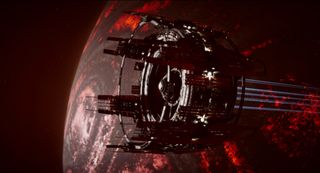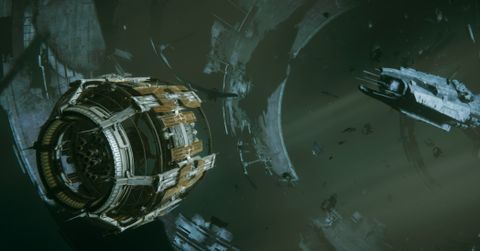Our Verdict
An enticing premise held back by uneven pacing and glaring technical issues.
PC Gamer's got your back
What is it? A Frostpunk-inspired space-colony sim that ensues after your tiny error of blowing up the moon.
Expect to pay: £30/$35
Release date: Out now
Developer: Bulwark Studios
Publisher: Kasedo Games
Reviewed on: Radeon 5700 XT, i5-9600K, 16GB RAM
Multiplayer: No
Link: Official site
Genre-hopping from the small-scale skirmishes of Warhammer 40,000: Mechanicus to the automated production chains that (ideally) keep Ixion’s colossal space station running, developer Bulwark comes up with a compelling premise: What do you do when your experimental vessel accidentally dislodges a chunk of the moon, ending humanity’s existence on Earth as a result? But the migration from squad-based tactics to colony administration and collective-trauma management comes with pacing issues and a cavalcade of technical hiccups.
You would think that, with so much Greek nomenclature going around (the first shuttle to dock at your station is identified as Charon, the mythological ferryman of the dead), someone would have bothered double-checking the brand on whose hands the future of humanity rests. You see, Dolos, the name both of the company that funds your ambitious endeavour into space and the CEO whose philanthropic proclamations sound fishy even before catastrophe strikes, means “malice” in Greek, which, in retrospect, paints the 'accident' that nearly wipes out the species in an entirely new light.

Stranded in a depressingly lifeless and suddenly inhospitable Milky Way, my first concern as administrator of the Tiqqun space station is to ensure the continued survival of the crew and discover what went so cataclysmically wrong during launch. As with similar base-building games, the beguiling enormity of the task ahead is masked by a reassuringly limited array of starting options: constructing essential buildings like living quarters and infirmaries, designing roads to facilitate transportation between them, and—most pressingly—tending to the station’s irreparably haemorrhaging outer shell, a hull ripped apart by the force of that world-shattering jump.
It’s balanced and calmly elegiac busywork for the first few hours, even if Bulwark decides to keep the training wheels on a bit too long as it schools novice administrators in how to stave off the two major threats: mutiny from an increasingly distressed crew and the hull dissipating into nothingness. To avoid that, I have to explore outside the ship for raw materials to convert into alloy, organise my limited space to accommodate the warehouses that store and plants that process them, and direct the routes of mining and cargo ships to optimise their flow into the Tiqqun. Ixion does an adequate job of introducing those logistical responsibilities during the first few hours but, at the same time, it felt like I was being held back too long—I was impatient to roam the galaxy.
As for crew morale, the same bleeping probes hurled into the void to seek out mineral-rich asteroids and floating mountains of ice will uncover event spots. Investigating these may answer urgent questions about your current situation, reveal caches of cryogenically frozen humans to thaw and add to your crew, or pinpoint sites of scientific data that can be retrieved and used to unlock new technologies that improve living conditions, as well as the chances of long-term survival.

These are enjoyable events that provide a degree of unpredictability and a welcome change of pace from the monotony of base-building. Their outcomes progress the plot of Tiqqun’s pilgrimage, shedding light on a convoluted backstory, sometimes presenting me with rather simplistic binary choices, but occasionally with something more exciting: the fragment of a plan. After all, subsisting on locally-harvested insect protein is good, but like any starfarer, what Ixion’s refugees crave is a cause for optimism, something to dream about.
A new hope?
That dream manifests as a set of coordinates. Protagoras, an experimental Dolos vessel that vanished from the solar system following the accident, was planning a route to a potentially habitable planet. The revelation triggers the first major shake-up in the game, not only in suggesting there’s more to it than a meagre existence orbiting Earth’s smouldering carcass, but in the rush for resources needed to upgrade the Tiqqun for the upcoming interstellar jump and subsequent pursuit.
It is at this point, after several hours of agreeable but rather uninspiring drudgery, that the game finally opens up with an exciting range of possibilities: an unknown star system to explore and freshly unlocked technologies to research, some of them with important ramifications in the way you manage your colony. For example, erecting a DLS Center allowed me to play the politician, implementing section-wide laws to increase productivity or blaring out propaganda to placate the restless masses, while building a Waste Treatment Center enabled recycling from the refuse of living quarters and processing factories, effectively manufacturing new resources out of nothing.

New hazards appear, too. A higher rate of work-related accidents and resultant power failures require you invest in resource-draining solar panels and batteries, while the growing displeasure of the crew, as each cycle grows into the next with little progress, instils a sense of urgency in your search for the elusive Protagoras lest their despair turns into anger. It’s a necessary escalation, as I had admittedly started getting a bit too comfortable by that point, but the game’s infuriating tendency to throw every mishap at me simultaneously made the sudden difficulty spike feel artificial and aggravating.
Event choices also become more demanding, sometimes necessitating the transfer of substantial caches from your ship, others endangering your science team for a single misstep (though some of those feel more like cheap gotcha moments than the logical outcome of a poor decision). And, of course, that ruptured hull, Ixion’s equivalent to Frostpunk’s insatiable generator, suffers more both with every section of the Tiqqun unlocked to make use of the extra space and with each interstellar jump that brings you closer to finding a permanent home. An emotionless announcement from the ship’s AI estimates it can withstand a maximum of four jumps—equivalent to game chapters.
Despite the accruing risks, it’s after each jump with a fresh star system to explore that Ixion is at its most exhilarating, when the focus shifts from piecing together the details of what’s already happened to mapping out a future yet to be written, a leap into the unknown. Unfortunately, it’s also where things start to break down.
Moon buggy

Wading toward the conclusion, almost as if buckling under the weight of its sheer number-crunching, Ixion’s significant technical issues come to the forefront: severe framerate drops, screen lock-ups, erratic menus. The bugs I’ve experienced ranged from the harmless (such as achievements unlocking before their conditions were met) to the playthrough-ruining. Restarting a chapter is the nuclear option Bulwark provides when all else fails, yet trying to do that after painting myself into a corner in Chapter 4 reloaded the first one instead. At one point, two-thirds of my crew inexplicably vanished. And when (in my third run) I finally managed to reach the ending, that last button press to lead my people to the promised land stayed cruelly greyed-out, even though I’d satisfied all requirements for it.
At times, it felt I struggled not so much against an intended challenge but against the game’s faulty circuitry, though it should be noted that an ongoing series of patches over the course of reviewing the game have addressed some of the more egregious problems, including the horrid last-button paralysis (though several others—like unresponsive controls and charts failing to update—persisted in my final playthrough).
Other, less accidental, flaws become apparent as the story progresses. Chapter-closing sequences often require a concerted effort toward a grand goal, such as awakening 2,000 souls from their cryopods, meaning there’s nothing interesting to do for long stretches of time, dousing your excitement at, ironically, the exact moment you yearn to go gallivanting somewhere new. Worse, the balance in the production-chain management which forms the interactive backbone of the game is inconspicuously harsh, letting you cruise for hours before the side-effects of a bad decision (such as the layout of an entire section, or spending too much energy toward a specific specialisation) become evident. One of the joys of the production-chain subgenre lies surely with the creative rush of uprooting and rebuilding on the fly. But the way Ixion stealthily slides into doom-spirals of unsustainability makes reloading preferable to redesigning.

Frustrated by the mounting setbacks but excited to see what lay ahead I quickly realised, after powering through the early chapters, that finding a new home for humanity would entail more than simply retrieving a set of coordinates. Locating Protagoras is the first step in a much longer quest that involves a surprisingly belligerent United-Nations taskforce tracking down Dolos vessels (you were responsible for destroying Earth, after all) and a mysterious group called the Black Market Society which engaged in shady dealings with both organisations.
Surprisingly, given the placid nature of the game up to that point, the final act evokes more Lovecraftian horror than the logistical challenges of a traditional base-builder; the mood in these tense moments elevated by the swelling choirs and ominous drones of Guillaume David’s consistently excellent soundtrack. Various endings become available depending on key decisions during your (roughly) 30-hour journey in that final chapter.
As the final refugee disembarked on that fabled Earth-like planet, my feelings were mixed: satisfaction for achieving closure in a compelling story and securing a future for humanity, but also relief in retiring a finicky, often counterintuitive management sim. Establishing those self-sustaining production chains, then sitting back and watching the Tiqqun operate smoothly on autopilot was, as ever, a deeply gratifying experience. But, at the same time, the numerous bugs, the long stretches of inactivity, and the disastrous, collapsing dominoes that could ensue from a single omission or bad decision made for a frequently maddening game; one whose biggest obstacles—whether designed or unintended—brought me little joy in overcoming.
An enticing premise held back by uneven pacing and glaring technical issues.

Borderlands 3 community scores a big win for science: 'These players have helped trace the evolutionary relationships of more than a million different kinds of bacteria that live in the human gut'

Hasbro wants to make another Baldur's Gate sequel but it's early days yet: 'We certainly hope that it's not another 25 years'

The blasphemy of playing Half-Life with a gamepad is now easier as Black Mesa gets a sudden weighty update, devs tease 'more dangerous patch' to come
